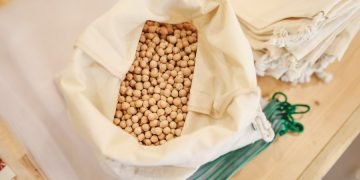While materials will vary between solar panel manufacturers, this article will give you a good general idea of the materials you can expect to find in the solar energy industry in general.
Frames are a key design feature of the solar panel. They help hold various components together, provide weather protection and help increase durability. Most solar panel frames are made from anodized or powder coated aluminum.
Anodized aluminum frames for solar panels.
Most high quality solar panels have an anodized aluminum frame and there are many benefits to using this material. Most importantly, it has the ability to reflect more heat, helping to improve the overall conversion efficiency of the solar cell.
Anodized aluminum is also easy to maintain. You can clean it periodically to restore its appearance. The material is unaffected by sunlight and often resists scratches better than powder coated alternatives.
The main disadvantage of anodized aluminum solar frames is that they only come in one color – silver. This can be a problem for architects and solar panel companies when trying to fit solar panels into the overall aesthetic of a building.
Powder-coated solar panel frames.
Composed of a powder-coated aluminum frame, solar panels are ideal for those who prefer style to function. Most frames of this type are black and blend better with dark tiles. However, they can come in a wide variety of colors to match the different elements of a new or existing building. You can even achieve a glossy, matte or satin finish with the powder coating technique.
The main disadvantage of powder-coated solar frames is that they scratch more easily than their anodized alternatives. The advantage here is that you can repair powder-coated materials, as opposed to scratches on anodized aluminum frames.
Base material.
Substrate materials are a key component in solar panel design. Their primary function is to improve efficiency by providing reliable electrical conductivity. From a safety point of view, while helping to insulate the panel, they also provide protection against electric shock.
We refer to solar panel substrates as photovoltaic back panels. They often consist of several different materials laminated together for high performance. These materials can vary significantly from manufacturer to manufacturer.
Solar cell materials.
Solar cells are perhaps the most important feature of a solar panel. It is the solar cell that is responsible for converting sunlight into electricity through the photoelectric effect.
Crystalline silicon elements.
Solar cells made from silicon are the most popular choice for today’s solar panels. We can divide crystalline silicon (c-Si) into different categories depending on the crystal size of the resulting silicon wafer used in the solar cell. The two most popular c-Si categories are as follows:
- Polycrystalline silicon – This type of solar photovoltaic cells, also known as “multicrystalline silicon”, is the most common. Due to their popularity and more efficient manufacturing process (using molten silicon), solar panels that use this type of cell are often the cheapest to buy.
- Monocrystalline Silicon – This is a highly efficient type of solar cell used in premium solar panels. They usually offer more power output than competing products, but are much more expensive. Solar panels that use single-crystal silicon cells have a characteristic pattern of small white diamonds.
Cells with thin film.
Solar panels using thin-film solar cells are less common than crystalline silicon alternatives. Although they are generally cheaper, their performance is not as good as that of c-Si technology. The advantage of thin-film cells is that they are flexible and therefore slightly more durable.
Recent advances in thin-film technology have helped close this gap, with some thin-film cells now outperforming polycrystalline silicon cells. However, single-crystal silicon technology is still far away.
The most popular materials in thin-film solar cells are:
- Amorphous silicon is a popular material widely used in thin-film solar cells. It uses about 1% of the silicon found in a traditional crystalline silicon cell, making it significantly cheaper.
- Cadmium Telluride – Cadmium solar cells are the only thin-film product that can compete with single-crystal silicon cells in terms of its characteristics. The disadvantage of this material is its high toxicity, which raises concerns about the disposal of old cadmium cells.
- Copper Indium Gallium Selenide (CIGS) is the third most popular thin-film solar cell technology. When compared to crystalline silicon, CIGS cells can be 80 to 160 times thinner.


























































